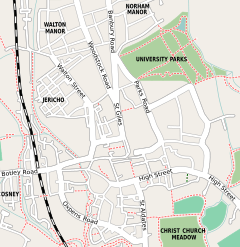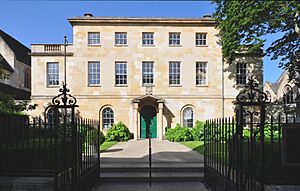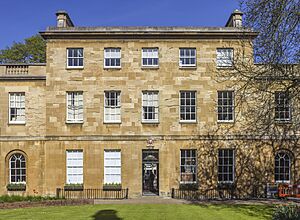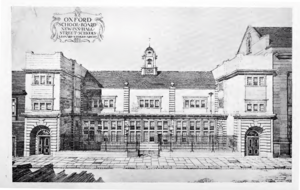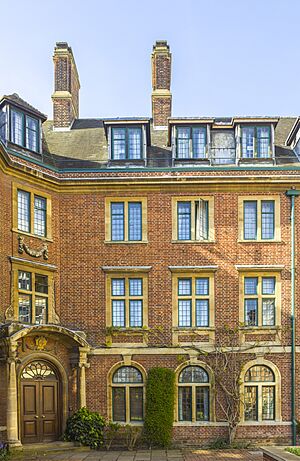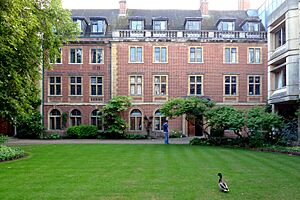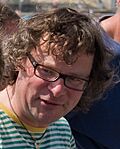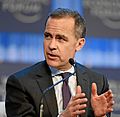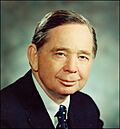St Peter's College, Oxford facts for kids
Quick facts for kids St Peter's College |
|||||||||||||||||
|---|---|---|---|---|---|---|---|---|---|---|---|---|---|---|---|---|---|
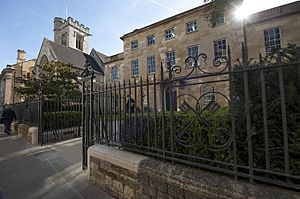
St Peter's College from New Inn Hall Street
|
|||||||||||||||||
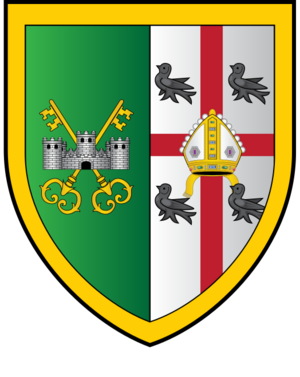
Blazon: Per pale vert and argent, to the dexter two keys in saltire or surmounted by a triple towered castle argent masoned sable and on the sinister a cross gules surmounted by a mitre or between four martlets sable, the whole within a bordure or.
|
|||||||||||||||||
|
|
|||||||||||||||||
| University | University of Oxford | ||||||||||||||||
| Location | New Inn Hall Street | ||||||||||||||||
| Coordinates | 51°45′10″N 1°15′39″W / 51.752762°N 1.260721°W | ||||||||||||||||
| Full name | The Master, Fellows and Scholars of the College of St. Peter le Bailey in the University of Oxford | ||||||||||||||||
| Latin name | Collegium Sancti Petri Juxta Ballium | ||||||||||||||||
| Motto | Dum Spiro Spero (Latin) | ||||||||||||||||
| Motto in English | While I breathe, I hope | ||||||||||||||||
| Established | 1929 (attained full college status in 1961) | ||||||||||||||||
| Named for | Saint Peter Church of St Peter-le-Bailey |
||||||||||||||||
| Previous names | St Peter's Hall (1929–1961) | ||||||||||||||||
| Sister college | None | ||||||||||||||||
| Master | Judith Buchanan | ||||||||||||||||
| Undergraduates | 381 | ||||||||||||||||
| Postgraduates | 217 | ||||||||||||||||
| Boat club | Boatclub | ||||||||||||||||
| Map | |||||||||||||||||
St Peter's College is one of the colleges that make up the famous University of Oxford in the United Kingdom. It is located on New Inn Hall Street in Oxford. The college stands on land that has been used for learning since the 14th century. Back then, there were two old university buildings called "medieval halls" on this spot.
The college you see today was started by Francis James Chavasse, who used to be a bishop. It opened in 1929 as St Peter's Hall. Later, in 1961, it became a full college and was renamed St Peter's College. When it first opened, only men could study there. But since 1979, both young men and women have been able to attend. In 2022, the college had about £53.9 million in its financial fund.
Contents
History of St Peter's College
How St Peter's Began
Even though St Peter's College is quite new, its location in Oxford is very old. It sits where two medieval halls once stood. These halls were places where students lived and studied many centuries ago. The first head of St Peter's called getting this land "a chance of ages."
One of the old halls was called Trilleck's Inn, which later became New Inn Hall. It was founded in the 1300s. Another hall, Rose Hall, was given to New College. Later, in the 1800s, New College sold the land to build a new church. This church is now the college chapel.
Becoming St Peter's Hall
The idea for the modern college started in 1923. Francis James Chavasse, a former bishop, noticed that studying at Oxford was becoming very expensive. He wanted to create a place where smart students could get an Oxford education, even if they didn't have a lot of money.
After Bishop Chavasse passed away in 1928, his son, Christopher Chavasse, started a fundraising campaign. They raised £150,000 to build and change the buildings on the site. St Peter's opened in 1928 with 13 students. The next year, in 1929, it was officially recognized and grew to 40 students. A very important helper was William Morris, 1st Viscount Nuffield, who also started Nuffield College.
During World War II, St Peter's Hall temporarily hosted female students from Westfield College. The St Peter's students moved to other colleges during this time.
From Hall to College
In 1947, St Peter's was given a new classification. Finally, in 1961, it became a full college after receiving a special document called a royal charter. In 1979, St Peter's started accepting women students, becoming a co-educational college.
Buildings at St Peter's
St Peter's College has many different kinds of buildings. Some of them are much older than the college itself. The college has changed older buildings to create places for students to live and study. It has also built new ones.
Linton Quad
Linton House is a beautiful building from 1797. It stands on the east side of Linton Quad, facing New Inn Hall Street. It was first built for the Oxford Canal Company. Later, it became a home for the church leader of St Peter-le-Bailey. Today, Linton House is the main entrance to the college and also holds the college library.
On the south side of this quad is the college chapel, which is the Church of St Peter-le-Bailey. It was built in 1874, using some stones from an even older church. This is the third church with that name to be on or near this spot since the 1100s. Inside the chapel, you can find memorials to the Chavasse family. These include Captain Noel Godfrey Chavasse's original grave cross and a large carving of Bishop Francis James Chavasse praying.
The Latner building is also part of the Linton Quad.
Hannington Quad
Hannington Hall is in the Hannington Quad. It was built in 1832 and is the only part left of the old New Inn Hall. This building was originally for students. When New Inn Hall joined Balliol in 1887, most of its buildings were taken down. But Hannington Hall survived. It was later bought and named after a missionary bishop, James Hannington. After St Peter's College was founded, it was changed to become the college's dining hall.
The Hannington Quad was created when a new building for student rooms was built behind the older structures.
Chavasse Quad
The Central Girls' School, located south of the college's original site, was finished in 1901. Between 1984 and 1986, it was turned into the college's Chavasse Building. This building now provides living spaces for students and rooms for classes. In 2018, the new Hubert Perrodo Building was completed, adding more student rooms and meeting spaces. The Middle Common Room (MCR) for postgraduate students and a music room are also in this quad.
Mulberry Quad
The Mulberry Quad is to the northwest of the Linton Quad. It gives direct access to the Junior Common Room (JCR). The Morris Building, which is now student housing, was a gift from Lord Nuffield in memory of his mother. The Matthews block houses the JCR and the student-run bar. The Dorfman Centre is in the northwest corner of the quad. Mulberry Quad also leads to Bulwarks Lane.
Canal House
Canal House is where the college master lives. It was built in the early 1800s.
Student Accommodation Outside the Main Site
St Peter's also has some student housing blocks a few minutes away from the main college. Students live in buildings on St Thomas' Street and St George's Gate. Postgraduate students and fourth-year undergraduates live on Paradise Street, which opened in 2008.
Student Life at St Peter's
The Junior Common Room (JCR) is run by students. It organizes many social events throughout the school year. These range from special formal dinners, like celebrating Burns Night with traditional food and poetry, to fun themed parties. The college also has its own student-written arts magazine called Misc, which comes out every term. There's also a student-run college bar.
Sports and Activities
The college has many sports teams. Students can play rowing, cricket, football, hockey, rugby, and pool. St Peter's shares a sports field with Exeter and Hertford Colleges. This field has cricket pitches, rugby and football pitches, a hockey pitch, tennis courts, and a squash court.
The college's boat club, St Peter's College Boat Club, often competes in rowing races. The club shares a boathouse with several other college boat clubs.
Locomotive Connection
A steam train, GWR 6959 Class locomotive no. 7900, was built in 1949. It was named "Saint Peter's Hall" after the college's original name. One of the metal nameplates from this train, which has since been taken apart, is kept at the college.
People Connected to St Peter's College
Masters of the College
- Christopher Maude Chavasse (1929–1940)
- Julian Thornton-Duesbery (1940–1944; 1955–1968)
- Robert Wilmot Howard (1945–1955)
- Alec Cairncross (1969–1978)
- Gerald Aylmer (1979–1991)
- John Barron (1991–2003)
- Bernard Silverman (2003–2009)
- Mark Damazer (2010–2019)
- Judith Buchanan (from October 2019)
Famous Alumni
Many notable people have studied at St Peter's College. Here are a few:
-
Ken Loach, a famous English film director
-
Mark Carney, who used to be the Governor of the Bank of England
-
Hugh Dancy, an actor and model
-
Nick Houghton, a former top military leader in the British Armed Forces
-
Carl Albert, a former Speaker of the United States House of Representatives
- Edward Akufo-Addo, the second President of Ghana
- Wilbert Awdry, who created Thomas the Tank Engine
- Simon Beaufoy, who wrote the screenplays for The Full Monty and Slumdog Millionaire
- Mark Carney, former Governor of the Bank of England
- Paul Condon, Baron Condon, former Commissioner of the Metropolitan Police
- Hugh Dancy, actor
- Hugh Fearnley-Whittingstall, chef and TV presenter
- Matt Frei, a BBC correspondent
- Geordie Greig, former editor of The Independent newspaper
- General Sir Nicholas Houghton, former Chief of the Defence Staff
- Libby Lane, the Bishop of Derby, who was the first woman to become a bishop in the Church of England
- David Moxon, former archbishop of New Zealand
- Paul Reeves, former archbishop of New Zealand and Governor-General of New Zealand
- Jake Wallis Simons, a British journalist and novelist
- Mark Stanhope, former head of the Royal Navy
- Jigyel Ugyen Wangchuck, former heir to the throne of Bhutan


